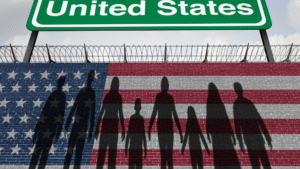
🧭 Introduction
The history of U.S. immigration laws reveals how America’s approach to citizenship and border control has evolved through war, economy, race, and national security. From the 1790 Naturalization Act to the executive orders of 2025, immigration law has continuously shaped—and been shaped by—social and political forces. This expert-level timeline covers the most impactful legislation, policy shifts, and court decisions, with a special focus on the 2025 legal landscape.
Last Updated: June 23, 2025
Author: Nahyan | UsLawGuide.net
📜 Evolution of U.S. Immigration Law: 1790–1965
🏛️ Early Legislation
- Naturalization Act (1790): Allowed only “free white persons” of good moral character to naturalize.
- Alien & Sedition Acts (1798): Authorized the president to deport non-citizens deemed dangerous.
- Steerage Act (1819): Required ship captains to submit passenger data and addressed shipboard conditions.
❌ Exclusion and Quotas
- Chinese Exclusion Act (1882): Banned Chinese laborers; followed by the Scott
Act (1888) and the Geary Act (1892).
- Immigration Acts of 1917, 1921, and 1924: Introduced literacy tests and quotas favoring Northern Europeans.
🔄 Post-War Policy Shift
- Immigration and Nationality Act (1952): Maintained quotas but removed racial restrictions.
- Hart–Celler Act (1965): Eliminated national-origin quotas, establishing the modern preference system and dramatically changing U.S. immigration demographics.
📈 Legal and Policy Developments: 1965–2025
📌 Trends Post-1965
Following 1965’s liberalization, immigration policies began tightening in the 1980s and 1990s in response to unauthorized immigration. The 2000s introduced measures focused on national security, especially post-9/11.
🧾 2025 Legal Highlights
- Executive Order 14159 (Jan 20, 2025): Increases expedited removal authority, penalizes sanctuary jurisdictions, and boosts enforcement funding.
- Laken Riley Act (Jan 29, 2025): Requires no-bond detention of undocumented immigrants charged with serious crimes.
- Proclamation 10949 (June 4, 2025): Limits entry from 12 countries deemed high-risk for national security.
- S.1589 Immigration Accountability Act: A bill under debate in Congress proposing reform of parole programs and asylum eligibility criteria.
These updates reflect renewed government focus on expedited enforcement and national security.
🔍 Legal & Social Foundations
🎯 Policy Objectives Over Time
Immigration law has always reflected national priorities:
- 1790–1920s: Prioritized racial and national origin restrictions
- 1965–2000: Focused on family reunification and employment
- 2001–2025: Emphasis on enforcement, terrorism prevention, and border control
⚖️ Role of the Courts
Important court decisions have affirmed key principles:
- Wong Kim Ark (1898): Affirmed birthright citizenship under the 14th Amendment.
- Fiallo v. Bell (1977): Upheld Congressional authority to distinguish immigration eligibility by gender and relationship.
- Arizona v. United States (2012): Reinforced federal primacy in immigration enforcement.
❓ Frequently Asked Questions
Q: What was the Hart–Celler Act’s legacy?
➡ It abolished racial quotas and diversified immigration by favoring family-based and skilled worker visas.
Q: What does Executive Order 14159 do?
➡ It allows faster deportation of undocumented immigrants and pressures sanctuary cities through funding restrictions.
Q: Does the Laken Riley Act apply to all undocumented immigrants?
➡ No. It targets only those charged with specific criminal offenses, requiring detention without bond during legal proceedings.
Q: Are immigration laws still evolving?
➡ Yes. Immigration policy in 2025 remains active, with ongoing court challenges, new executive actions, and proposed federal reforms.
⚠️ Disclaimer
This content is for informational purposes only and should not be interpreted as legal advice. Immigration law is complex and highly fact-specific. Readers should consult a licensed immigration attorney for personal guidance.
🔗 Internal & External Links
External Sources:
- History of U.S. Immigration Policy—History.com
- Legal Information Institute—Cornell Law
- Pew Research—Immigration Policy Evolution
- Executive Order 14159—Wikipedia
Internal Links (uslawguide.net):